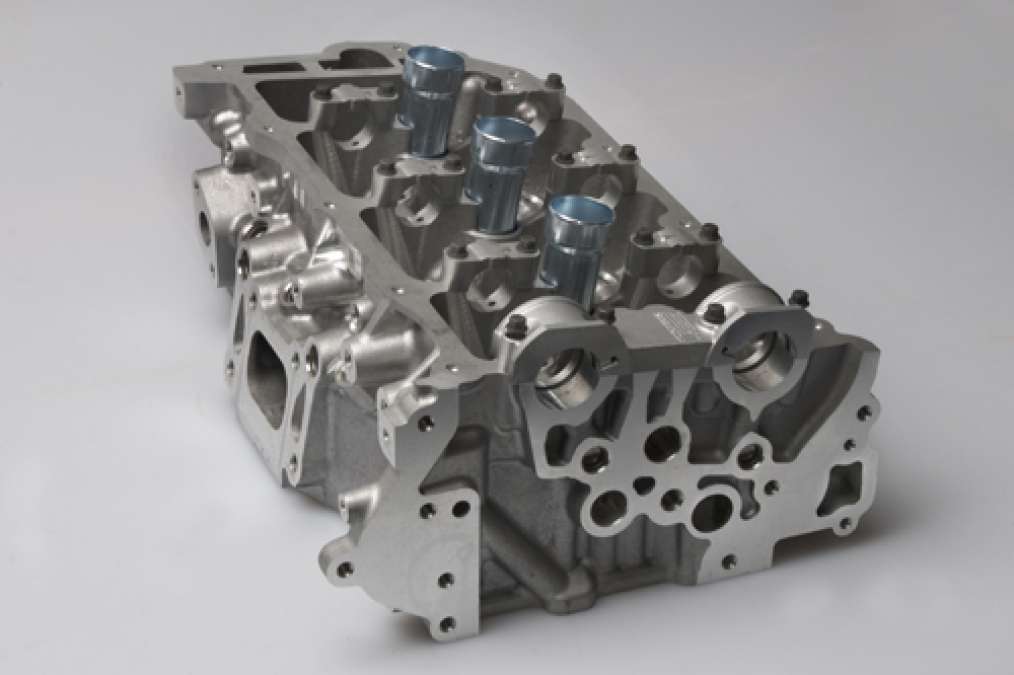The 2011 Camaro's V-6 engine has a conventional aluminum cylinder head with a cast iron exhaust manifold, but the new design integrates the exhaust manifold with the head, reducing the engine's weight by 13 lbs.
"Reducing engine mass of this magnitude doesn't happen often," said Ameer Haider, GM assistant chief engineer for V6 engines, in a news release today. "Engineering usually looks for reduction in terms of grams not pounds." Haider compared it to removing a set of golf clubs from your car when you don't need them. It saves fuel by making the engine haul around less weight.
The new cylinder head/exhaust manifold design was matched by extensive simulation and bench testing, according to Chevrolet, for improved cylinder-head airflow. Intake airflow is improved seven percent with the use of larger intake valves (38.3 mm v. 36.9 mm). Chevy credits the bigger valves as the primary source of an increase of 11 horsepower. Exhaust flow is 10 percent better than the previous V6.
Compared to the 3.6L V-6 in 2011 models, the new LFX engine features:
• New cylinder head design with integrated exhaust manifold
• Improved intake port design and larger intake valves within the cylinder heads
• Longer-duration intake camshafts
• Composite intake manifold
• New fuel pump and isolated fuel rail
• New, optimized-flow fuel injectors
• Structural front cover and cylinder block enhancements
• Stronger and lighter-weight connecting rods
• Camshaft cap and throttle body design enhancements
Total engine weight is reduced by 20.5 lbs. The new composite intake manifold saves approximately 5.5 pounds (2.5 kg) over the current aluminum intake. Additionally, a lighter-weight structural front cover and lighter-weight, high-strength connecting rods make up the rest of the engine weight savings. The powdered metal connecting rods use a higher ratio of copper, which makes them stronger and therefore makes additional weight savings possible.
Additionally, the optimized-flow fuel injectors and integrated exhaust manifolds/cylinder heads promote lower emissions. The design moves the catalytic converter closer to the engine exhaust point, heating the catalyst sooner which means the emissions reduction process begins sooner, and therefore lower emissions.
Along with its weight savings, the composite intake manifold has a smaller radiated surface area so noise and vibration characteristics are comparable to the previous aluminum manifold. The new fuel pump is quieter, while the isolated fuel rail further reduces fuel system noise. Even more noise reduction came from the redesigned front engine cover. Additional support ribs on the backside and an additional fastener reduce noise and vibration.
Additional engine enhancements include new saddle-type caps for the camshafts for improved durability, and the throttle body is updated with a new, digital throttle position feature that eliminates a previous mechanical contact for more trouble-free operation.
The 2011 Chevrolet Camaro has a power rating of 312 hp. With an increase of 11 horsepower, total output goes to 323 horses for 2012, a remarkable number that not long ago could be achieved only from a V-8. Of course, not long ago--last year, to be exact--Chevrolet hadn't combined the exhaust manifold with the cylinder head.






Comments
Well that's a stupid idea.
Permalink
Now when the exhaust studs break off, you'll have to pull the head instead of just the exhaust manifold.